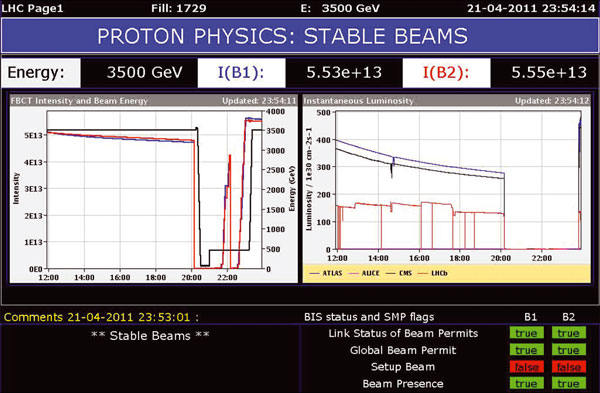
Just before midnight on 21 April, the LHC set a new world record for beam intensity at a hadron collider when its beams collided with a peak luminosity of 4.67 × 1032 m–2s–1. This exceeds the previous world record of 4.024 × 1032 cm–2s–1, which was set by Fermilab’s Tevatron collider in 2010, and marks an important milestone in LHC commissioning. The new record, made with 480 bunches per beam, lasted only a couple of days before collisions with 768 bunches per beam delivered around 8.4 × 1032 cm–2s–1. By the time a period of machine development began in the first week in May, the integrated luminosity for ATLAS and CMS for 2011 had reached more than 250 pb–1.
Early in April, a period of “scrubbing” took place to improve the surface characteristics of the beam pipe. This run saw more than 1000 high-intensity bunches per beam circulating at 450 GeV with 50 ns spacing. Given the potential luminosity performance (more bunches, higher bunch intensity from the injectors), the decision was taken to continue the 2011 physics run with this bunch spacing.
For 50 ns injection into the LHC, the Super Proton Synchrotron (SPS) takes batches of 36 bunches from the Proton Synchrotron. Since the scrubbing run, the LHC has passed through 228, 336, 480 and 624 bunches per beam to reach the latest total of 768. Each step-up of 144 bunches represents two extra injections of 72 bunches (2 × 36) from the SPS. This is a considerable amount of beam power and the injection process needs to be carefully tuned and monitored. A few days is spent delivering physics after each step-up to check the performance of the machine and make sure that no intensity-dependent effects are compromising machine protection.
The push-up in the number of bunches will continue towards a potential maximum for the year of around 1400.





